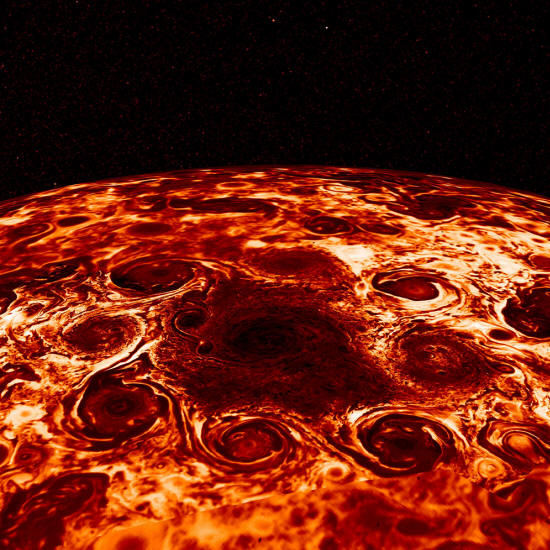|

by Becky Ferreira
September
22, 2022,
from
VICE Website

Image: NASA
The
stable, geometric arrangements
of
mind-bogglingly huge vortexes
are still
unexplained and may hint
at new
physics...
At the poles
of Jupiter, enormous cyclones swirl
in neat geometric patterns that stay stable for years at a time, a
phenomenon that remains unexplained and that scientists have said
hints at the need for new physics.
The hurricane-force storms were first discovered by NASA's
Juno mission, which has captured
unprecedented observations of Jupiter since it arrived in orbit
around the planet in 2016.
In the planet's
northernmost region, a central cyclone is located near the pole,
while eight others dance around it at lower circumpolar latitudes in
an octagonal pattern.
In the south, a similar
cluster of five cyclones form the shape of a pentagon.
Now, scientists led by Andrew Ingersoll, who serves as
Earle C. Anthony Professor of Planetary Sciences at the
California Institute of Technology, have shed new light on the
strange storms that encircle Jupiter's north pole, each of which is
about as large as the continental United States.
Their results suggest that,
an "anticyclonic
ring" of winds that blow in the opposite direction of the
cyclones "is needed for the stability of the polygonal pattern,"
though the team noted that other questions about the storms
remain, according to a study (Vorticity
and divergence at scales down to 200km within and around the
polar cyclones of Jupiter) published on Thursday in
Nature Astronomy.
"Since 2017 the Juno spacecraft has observed a cyclone at the
north pole of Jupiter surrounded by eight smaller cyclones
arranged in a polygonal pattern," the researchers said in the
study.
"It is not clear why
this configuration is so stable or how it is maintained."
"The polygons and the individual vortices that comprise them
have been stable for the four years since Juno discovered them,"
the team added.
"The polygonal
patterns rotate slowly, or not at all….In contrast, Saturn has
only one vortex, a cyclone, at each pole."
To get a firmer read on how the polygons form and then remain so
steady, Ingersoll and his colleagues measured the winds and dynamics
of the extraterrestrial tempests with Juno's Jovian InfraRed
Auroral Mapper (JIRAM)
instrument.
JIRAM is able to spot
details of the poles down to scales of 180 kilometers (110 miles), a
resolution that exposes a torrent of winds that acts as a kind of
brace for the cyclones, which is the key to their stability.
However, what the team weren't able to see in the observations is as
consequential as what they did spot.
The researchers noted
that they did not find "the expected signature of convection," the
process by which heat is transferred through churning fluids, in
contrast to previous research, according to the study.
Ingersoll and his colleagues said that future work is needed to
reconcile these conflicting datasets, noting in their new work that,
"a parallel study of
Jupiter's south polar vortices, focusing on vorticity and
stability, represents a step in the right direction."
These beautiful geometric
storms are just one of many mysterious processes on Jupiter that
scientists are hoping to probe with missions such as Juno, or the
newly launched James Webb Space Telescope.
As the solar system's
biggest planet, Jupiter has no lack of bizarre and unique phenomena,
but it can also serve as a model to understand similar observations
on other planets, including Earth.
"These cyclones are
new weather phenomena that have not been seen or predicted
before," said Cheng Li, a Juno scientist at the
University of Michigan, Ann Arbor, and a co-author of the new
study,
in a 2019 NASA statement about previous research.
"Nature is revealing new physics regarding fluid motions and how
giant planet atmospheres work," he said.
"We are beginning to
grasp it through observations and computer simulations. Future
Juno flybys will help us further refine our understanding by
revealing how the cyclones evolve over time."
|


